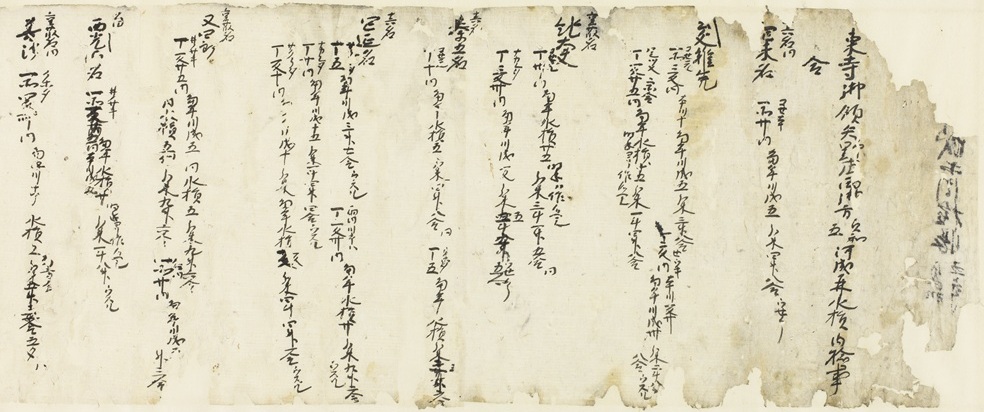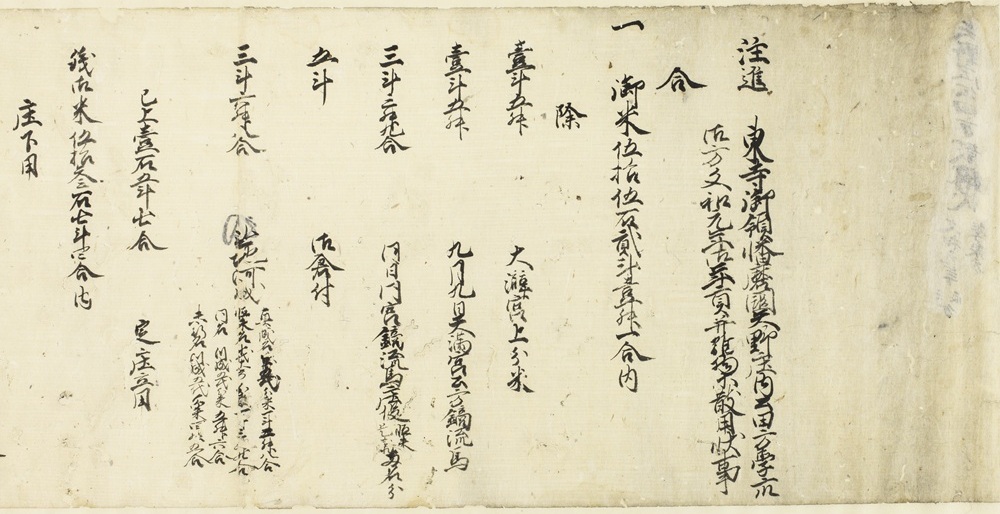Service restored - [Trouble]Kyoto University Rare Materials Digital Archive (Apr. 28)
The service has been restored (2025/04/28/13:00).
As of 9:30 a.m. on April 28, 2025, Kyoto University Rare Materials Digital Archive is unavailable due to trouble.
We are investigating the cause of the failure. We apologize for your inconvenience.
[Digital Archive Section , Main Library]
Service restored -[Maintenance] Kyoto University Rare Materials Digital Archive (Mar. 31)
The Maintenance work was completed (2025/3/31 9:10) and the service has been restored.
Kyoto University Rare Materials Digital Archive will suspend its service due to the system maintenance for about 15 minutes from 9:00 am, March 31, 2025.
The service will be restored as soon as the maintenance work has been completed. Thank you for your understanding.
[Library Network] Kyoto University Rare Materials Digital Archive: 310 items from the Kyō-ō Gokokuji Documents held by the Kyoto University Museum have been newly released
The Kyō-ō Gokokuji Documents (monjo) were discovered by Toshihide Akamatsu in the treasure house of Toji Temple in 1937. After the war, Kyoto University borrowed, organized and transcribed them. In 1968, they were given to Kyoto University. In 1971, these documents designated as a National Important Cultural Property. The collection consists of 3043 documents that date from the Heian period (794-1185) through the Azuchi-Momoyama period (1568-1600).
This time, images of 310 of these documents has been newly released on Kyoto University Rare Materials Digital Archive.
▼The Kyoto University Museum - Kyō-Ō Gokokuji Documents

"東寺湯結番定文"
As of March 27, 2025, Kyoto University Rare Materials Digital Archive provides 2,155,567 images of 25,905 titles.
[Library Network] Kyoto University Rare Materials Digital Archive: Old Map of Yoshida Village in Yamashiro Province has been newly released
Old Map of Yoshida Village in Yamashiro Province held by the Kyoto University Museum has been newly released on Kyoto University Rare Materials Digital Archive.
The old map of Yoshida Village in Yamashiro Province (山城国吉田村古図) is a colored map showing the status of land ownership in Yoshida Village, Otagi-gun, Yamashiro Province, including the area that corresponds to the present-day Yoshida Campus of Kyoto University. This map measures about 176 cm x 265 cm, with annotations of the place, lot numbers, areas, owners, and tax payment recipients. Based on the content, it is estimated to have been drawn between the late 18th and mid-19th century.
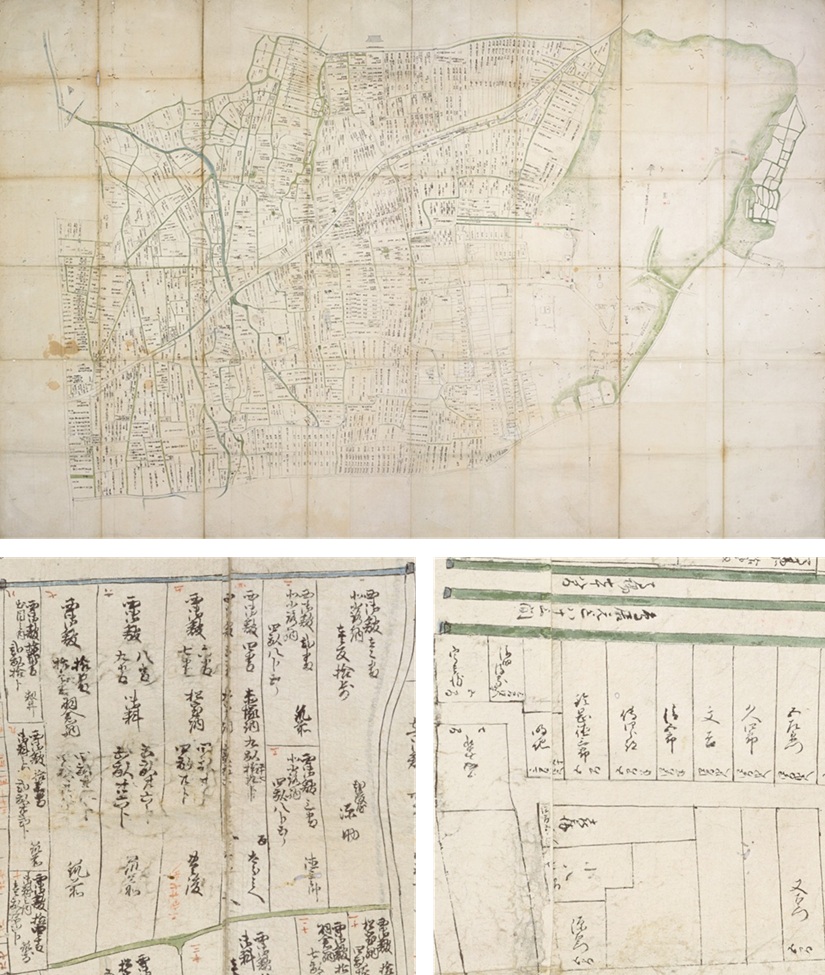
Above: whole map / Below left: fields / Below right: residental land
The original of the map can be seen in the special exhibition at the Kyoto University Museum from March 19 (Wed) to May 11 (Sun), 2025 (*Only duplicate will be displayed from March 19 to April 13, 2025).
As of March 19, 2025, Kyoto University Rare Materials Digital Archive provides 2,154,630 images of 25,595 titles.
[Library Network] Kyoto University Rare Materials Digital Archive: 12 items from Dutch trade documents have been newly released
12 items from Dutch trade documents held by the Kyoto University Museum have been newly released on Kyoto University Rare Materials Digital Archive.
▼Dutch trade document at Dejima, Nagasaki
Documents related to the arrival of the “Schip Handelmaat Schappy” at Dejima in 1827, 12 items in total. Germain Felix Meijlan, whose name appears as the author of the documents, was the head of the Dutch trading post in Nagasaki from August 1826 to October 1830.
The purchase ledger shows “purchase” of “Holländischer Händel in Japan (Dutch trade document) 1818-27, 1 copy (12 sheets)”on July 17, 1911. The content descriptions of the metadata were based on a catalog prepared by Naojiro Murakami, a pioneer in the study of the history of Japan-Europe relations, who at the time was the director of the former Tokyo School of Foreign Studies.

As of March 4, 2025, Kyoto University Rare Materials Digital Archive provides 2,154,629 images of 25,594 titles.
| Record ID | Title | Publication year (Japan) | Collection |
| RB00034908 | Directives to ship captains regarding Japanese sea lanes | 1818(文政1)年5月7日 | Museum |
| RB00034909 | Additional directives concerning Japan | - | |
| RB00034910 | An agreement between Dutch trading houses and Dutch ship captains | 1827(文政10)年 | |
| RB00034911 | Orders given by Meijlan | 1827(文政10)年11月9日 | |
| RB00034912 | Letters from Meijlan | 1827(文政10)年9月11日 | |
| RB00034913 | A copy of regulations concerning the hoisting of national flags of ships entering Japanese waters | (1760(宝暦10)年6月14日) | |
| RB00034914 | Orders given by Meijlan | - | |
| RB00034915 | A notice given by Meijlan | 1827(文政10)年7月26日 | |
| RB00034916 | Letters from Meijlan | 1827(文政10)年7月25日 | |
| RB00034917 | A roster of imports | - | |
| RB00034918 | A roster of exports | - | |
| RB00034919 | A roster of imports by weight | - |
[Library Network] Kyoto University Rare Materials Digital Archive: Suruga Date Documents (Early-modern) have been newly released
65 items from Suruga Date Documents (Early-Modern) held by the Kyoto University Museum have been newly released in Kyoto University Rare Materials Digital Archive.
▼Suruga Date Documents (Early-Modern)
The Suruga Date, a family sharing the same ancestor as the famous Date Masamune of Northern Japan were a warrior (kokujin) family based in Suruga Province (currently known as Shizuoka Prefecture). They moved to Tsuyama domain in Mimasaka province (current day Okayama Prefecture) where they survived during the Early Modern era (1600-1868). In all, 121 documents survive in the Suruga Date collection, with the oldest dating from the fourteenth century, and the most recent dating from the late nineteenth century (Meiji era).
Documents from the Early Modern to the Meiji era are available now. The documents cover a wide range of topics, but at the heart of them are those relating to the dispute over the Date family name from 1690 to the following year.
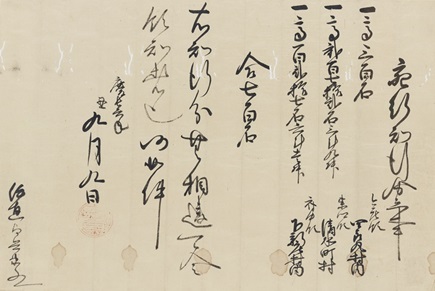
Yūki Hideyasu shuinjō 結城秀康朱印状
Please also see the 56 medieval documents.
▼Suruga Date Documents (Medieval)
As of February 13, 2025, Kyoto University Rare Materials Digital Archive provides 2,154,597 images of 25,582 titles.
[Library Network] Kyoto University Rare Materials Digital Archive: 7 items including “文机談” from Kikutei Collection digitized
7 items including “文机談” from Kikutei Collection held by the Main Library are now available in Kyoto University Rare Materials Digital Archive.
Kikutei Collection is an assembly of manuscripts and books handed down through the Kikutei Family founded by Kanesue (1281-1339; 兼季), the forth son of Sanekane Saionji (1249-1322; 西園寺実兼). The Kikutei (Imadegawa) Family was designated one of the highest status court families called the Seiga (清華) family which members can be appointed as Daijō-daijin (太政大臣) and served as biwa (Japanese lute) players. The collection includes many records of the court rituals, documents on music and instruments, and diaries hand-written by nobles.
The collection deposited in 1921 and 1923 and additional documents and scrolls of portraits related to the Kikutei Family were donated to the Main Library, Kyoto University by the owner of the collection and were formally registered as the holdings of the library in January 2021.
Bunkidan (文机談) is a collection of musical stories centered around the biwa (Japanese lute), compiled during the Bun'ei period (1264-1275). The book vividly describes the schools and masters of the biwa, and is an important source for understanding the history of music from the Heian to Kamakura periods. The second volume contains the story of Kamo no Chōmei (鴨長明), who was fond of playing the biwa.
According to the legend of the Kikutei family, the manuscript is considered to be an autograph copy by the author, Bunkibō Ryūen (文机房隆圓). However, it is actually believed to be a transcription from the late Kamakura period, not long after the work’s completion. Among the nine known versions of Bunkidan, the book of the Kikutei Collection is the oldest. Five volumes in five booklets are extant, although some pages are missing.
The second through fifth volumes were written on the reverse side of letters. In the digitization process, we restored the damaged papers, disassembled the books, and digitized all documents written inside of the pages. By making these reverse-side documents publicly available for the first time, it is hoped that further examination will determine the date of transcription in the future.
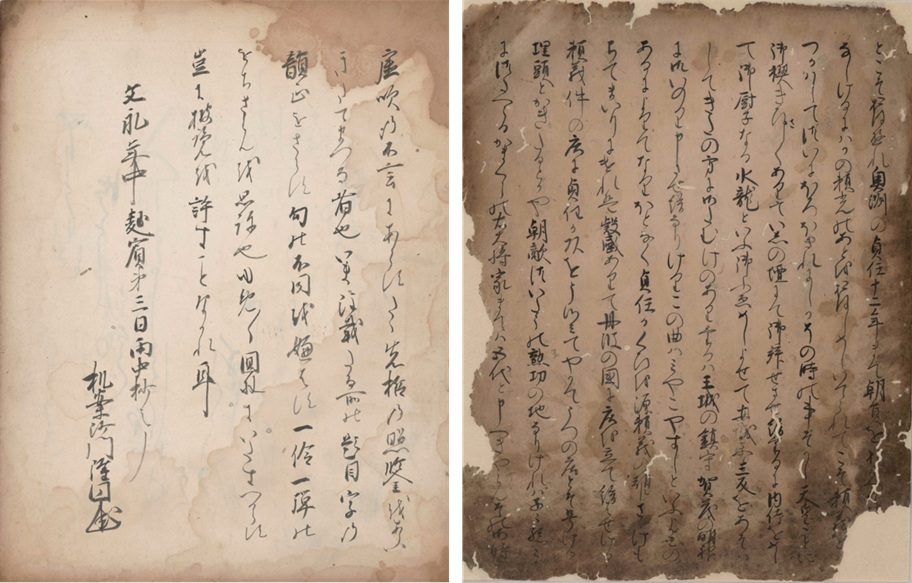
“文机談” Left: Signature by Ryūen / Right: Beginning of the first volume
In addition, six other titles are also available, including Korefusa Kōki (惟房公記), the autograph diary of Madenokōji Korefusa (万里小路惟房; 1513-1573), a Sengoku period lord, and a floor plan of the Kikutei residence.
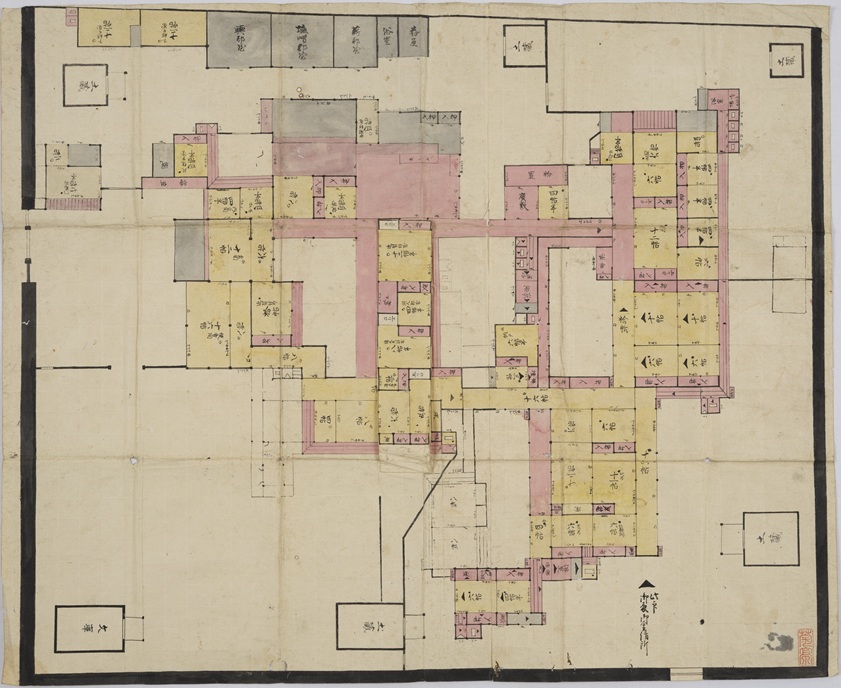
As of January 30, 2025, Kyoto University Rare Materials Digital Archive provides 2,154,407 images of 25,517 titles.
| Record ID | Title | Author | Call No | Collection |
| RB00028140 | 文机談 | (僧)隆円著 | 菊||フ||12 | Kikutei Collection |
| RB00028331 | 白馬節会 | 菊||巻||82 | Kikutei Collection | |
| RB00028346 | 日次記 不足 | 藤原宣胤并寫 | 菊||巻||99 | Kikutei Collection |
| RB00028352 | 惟房公記 | 菊||巻||103 | Kikutei Collection | |
| RB00028364 | [不知記] | 菊||巻||114 | Kikutei Collection | |
| RB00028365 | [不知記] | 中山定親記カ | 菊||巻||115 | Kikutei Collection |
| RB00034905 | 邸宅指図 | 文書9-25 | Kikutei Collection |
[Maintenance] Kyoto University Rare Materials Digital Archive (Nov. 25)
The Maintenance work was completed (2024/11/25 13:30) and the service has been restored.
Kyoto University Rare Materials Digital Archive will suspend its service due to the system maintenance.
The service will be restored as soon as the maintenance work has been completed.
Thank you for your understanding.
[Library Network] Kyoto University Rare Materials Digital Archive: Kitaro Nishida's donated books in memory of his deceased son have been newly released
Kitaro Nishida's donated books in memory of his deceased son are now available in Kyoto University Rare Materials Digital Archive.
Kitaro Nishida was one of Japan's leading philosophers, but in his personal life he suffered repeated deaths and illnesses in his family.
In June 1920, his eldest son, Ken, who was about to graduate from the Third Higher School, died suddenly of peritonitis at the age of 23. In November 1920, Nishida donated six titles of philosophy books to the library of the Third Higher School (currently Yoshida-South Library of Kyoto University), with the words “In memory of my late son Ken” written in India ink.
Three of the books have photos of Ken in his high school uniform and six tanka poems written by Nishida. These tanka poems honestly express Nishida's deep grief over the loss of his beloved child.
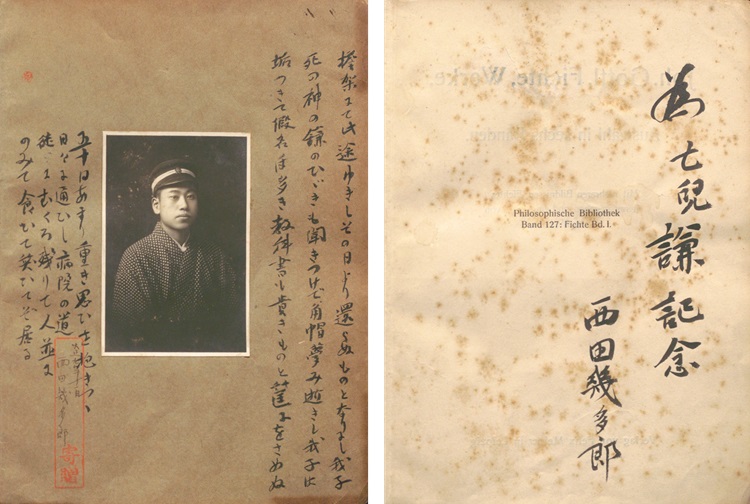
Werke : Auswahl in sechs Bänden Bd.1
The donated books were used as general books at the time, but are now designated as rare books. Nishida probably hoped that the books with his son's name on them would be preserved in the library of his alma mater for a long time, so that many people could see them. These books express the greatest sorrow of the philosopher who said, “The motive of philosophy must be the grief of life, rather than 'surprise.'”
As of November 13, 2024, Kyoto University Rare Materials Digital Archive provides 2,154,091 images of 25,510 titles.
(In this digitization, only the written parts were digitized, not the full texts.)
*Reference
Kyoto School Archive. (2024, November 13) Site of Kitaro Nishida's ‘Philosophy of Grief.’
| Library | Record ID | Call No | 請求記号 |
| Yoshida-South Library | RB00034320 | [西田幾多郎遺墨](Kritik der reinen Vernunft) | 210||||179||三高洋 |
| RB00034321 | [西田幾多郎遺墨](Werke : Auswahl in sechs Bänden Bd.1) | 210||||180||三高洋 | |
| RB00034322 | [西田幾多郎遺墨](Präludien : Aufsätze und Reden zur Einführung in die Philosophie Bd.1) | 210||||181||三高洋 | |
| RB00034323 | [西田幾多郎遺墨](Einleitung in die Philosophie) | 210||||182||三高洋 | |
| RB00034324 | [西田幾多郎遺墨](Der Gegenstand der Erkenntnis) | 210||||183||三高洋 | |
| RB00034325 | [西田幾多郎遺墨](The four historical conceptions of being) | 210||||184||三高洋 |
[Library Network] Kyoto University Rare Materials Digital Archive: Important Cultural Property "Dainihonshi hensan kiroku" vol.56-61 (G.S. Letters) newly released
The Graduate School of Letters of Kyoto University and the Kyoto University Museum have been carrying out the restoration and digitization of an important cultural property Dainihonshi hensan kiroku held by the Graduate School of Letters since academic year 2017. 202 images of the restored volumes 56-61 are now available in Kyoto University Rare Materials Digital Archive.
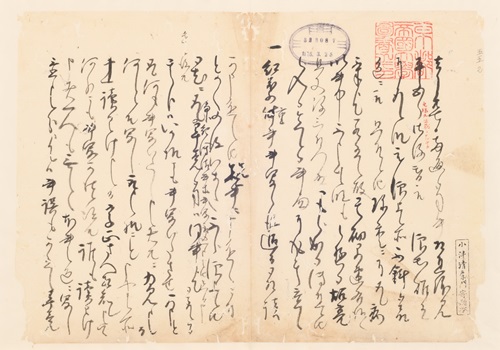
▼Important Cultural Property - Dainihonshi hensan kiroku (G.S. Letters)
Dainihonshi hensan kiroku (大日本史編纂記録) is a collection of more than 6,000 letters (copies) exchanged between Shokokan (彰考館; Mito Domain’s office for history compilation) in Mito (currently in Ibaraki Prefecture) and Edo (currently Tokyo) and their Kyoto office regarding the compilation of Dainihonshi (*1) by Tokugawa Mitsukuni (徳川光圀; 1628-1701). A total of 42,810 people and organizations and 15,159 historical records and literature works are mentioned in the letters and the content covers a wide range of aspects of the time, such as history, literature, Confucianism and Japanese classical literature, as well as the publishing culture during the Genroku Period, which makes this rare material a first-class historical record.
The rare material, before being restored, consisted of 248 volumes of about 10,000 sheets (one sheet folded in half to form a pouch makes two pages) in the form of fukuro-toji yotsume-toji (袋綴四つ目綴装) with sheets of papers folded at the fore edge and sewn at the back edge at four points. However, the rebinding and restoration done to the material during the Edo period were not appropriate to secure its long-term preservation; they also made it impossible to read the majority of the volumes without damaging them, because the text near the back edge was sewn inside the spine.
Therefore, a restoration project was launched in academic year 2017 funded by the Sumitomo Foundation (2017-2022), and also by government (2021-2023). The Graduate School of Letters has also set up Kyoto University Fund for the restoration of its library collection and the Kyoto University Museum acquired the university's special budget for this project in 2018.
Each volume of Dainihonshi hensan kiroku is to be released on the Internet through Kyoto University Rare Materials Digital Archive upon the completion of restoration and digitization processes. As of November 8, 2024, the Digital Archive provides 2,154,076 images of 25,504 titles.
